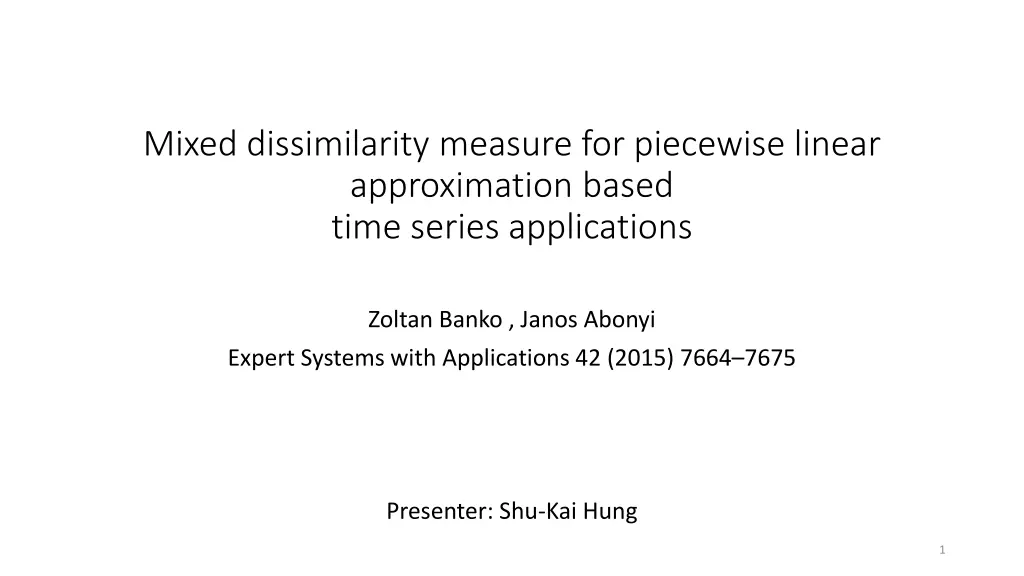
Mixed Dissimilarity Measure for Time Series Applications
"Explore a novel mixed dissimilarity measure known as MDPLA for piecewise linear approximation in time series applications. Learn how combining different comparison methods improves system effectiveness without altering time series representation, leading to enhanced performance and reduced unwanted alignments in dynamic time warping." (Approximately 294 characters)
Download Presentation

Please find below an Image/Link to download the presentation.
The content on the website is provided AS IS for your information and personal use only. It may not be sold, licensed, or shared on other websites without obtaining consent from the author. If you encounter any issues during the download, it is possible that the publisher has removed the file from their server.
You are allowed to download the files provided on this website for personal or commercial use, subject to the condition that they are used lawfully. All files are the property of their respective owners.
The content on the website is provided AS IS for your information and personal use only. It may not be sold, licensed, or shared on other websites without obtaining consent from the author.
E N D
Presentation Transcript
Mixed dissimilarity measure for piecewise linear approximation based time series applications Zoltan Banko , Janos Abonyi Expert Systems with Applications 42 (2015) 7664 7675 Presenter: Shu-Kai Hung 1
Abstract(1/3) In recent years, expert systems built around time series-based methods have been enthusiastically adopted in engineering applications, thanks to their ease of use and effectiveness. This effectiveness depends on how precisely the raw data can be approximated and how precisely these approximations can be compared. When performance of a time series-based system needs to be improved, it is desirable to consider other time series representations and comparison methods. The approximation, however, is often generated by a non-replaceable element and eventually the only way to find a more advanced comparisonmethod is either by creating a new dissimilarity measure or by improving the existing one further. 2
Abstract(2/3) In this paper, it is shown how a mixture of different comparison methods can be utilized to improve the effectiveness of a system without modifying the time series representation itself. For this purpose, a novel, mixed comparison method is presented for the widely used piecewise linear approximation (PLA),called mixed dissimilarity measure for PLA (MDPLA). It combines one of the most popular dissimilarity measure that utilizes the means of PLA segment 3
Abstract(3/3) On the basis of empirical studies three advantages of such combined dissimilarity measures are presented. First, it is shown that the mixture ensures that MDPLA outperforms the most popular dissimilarity measures created for PLA segments. Moreover, in many cases, MDPLA provides results that makes the application of dynamic time warping (DTW) unnecessary, yielding improvement not only in accuracy but also in speed. Finally, it is demonstrated that a mixed measure, such as MDPLA, shortens the warping path of DTW and thus helps to avoid pathological warpings, i.e. the unwanted alignments of DTW. This way, DTW can be applied without penalizing or constraining the warping path itself while the chance of the unwanted alignments are significantly lowered. 4
Theoretical background-Time series classification Time series : A time series is a sequence of data points, measured typically at successive times spaced at uniform time intervals. Classification : algorithm time series 5
dynamic time warping(DTW) Two times series: X = (1,1,2,3,2,0) Y = (0,1,1,2,3,2,1) 6
Piecewise linear approximation PLA segment of time series x is described by four numbers: ??: ??: ?(??): ?? ?(??): ?? Segmentation method : Top-down or bottom-up 7
MPLA(means of Piecewise linear approximation) MPLA(means of Piecewise linear approximation) generalized dissimilarity measure between two PLA segments ?(?) and ?(?) for DTW by comparing the means of segments: SPLA(slope SPLA(slope- -based of Piecewise linear approximation) based of Piecewise linear approximation) y = mx +c 8
MDPLA (Mixed dissimilarity measure for piecewise linear approximation) mixed dissimilarity measure ??????was defined by the authors between univariate time series x and y: 0 W???? 1 WS???= 1 - W???? WHY MIX? ????? (mean) ?S??? (trend) 10
Validation results Segmentation Alignment: DTW TABLE(MPLA,SPLA,MDPLA) 11
SAX(symbolic aggregate approximation) Allows a time series of arbitrary length n to be reduced to a string of arbitrary length w (w<<n) Step 1: Reduce dimension by PAA + = i j w 1 ) 1 ( n i w = c c w i j n n example: 8 5 = j = C Cj 2 20 5 12
Step 2: Discretization (Words: 8 Alphabet: 3) Determine breakpoints that will produce a equal-sized areas under Gaussian curve( ). c c c b b b a a - - 0 0 40 60 80 100 120 20 13
MPLA : 3 SPLA : 2 MDPLA : 8 SAX : 7 MPLA : 3 SPLA : 4 MDPLA : 14 SAX :2 (warping) 15
